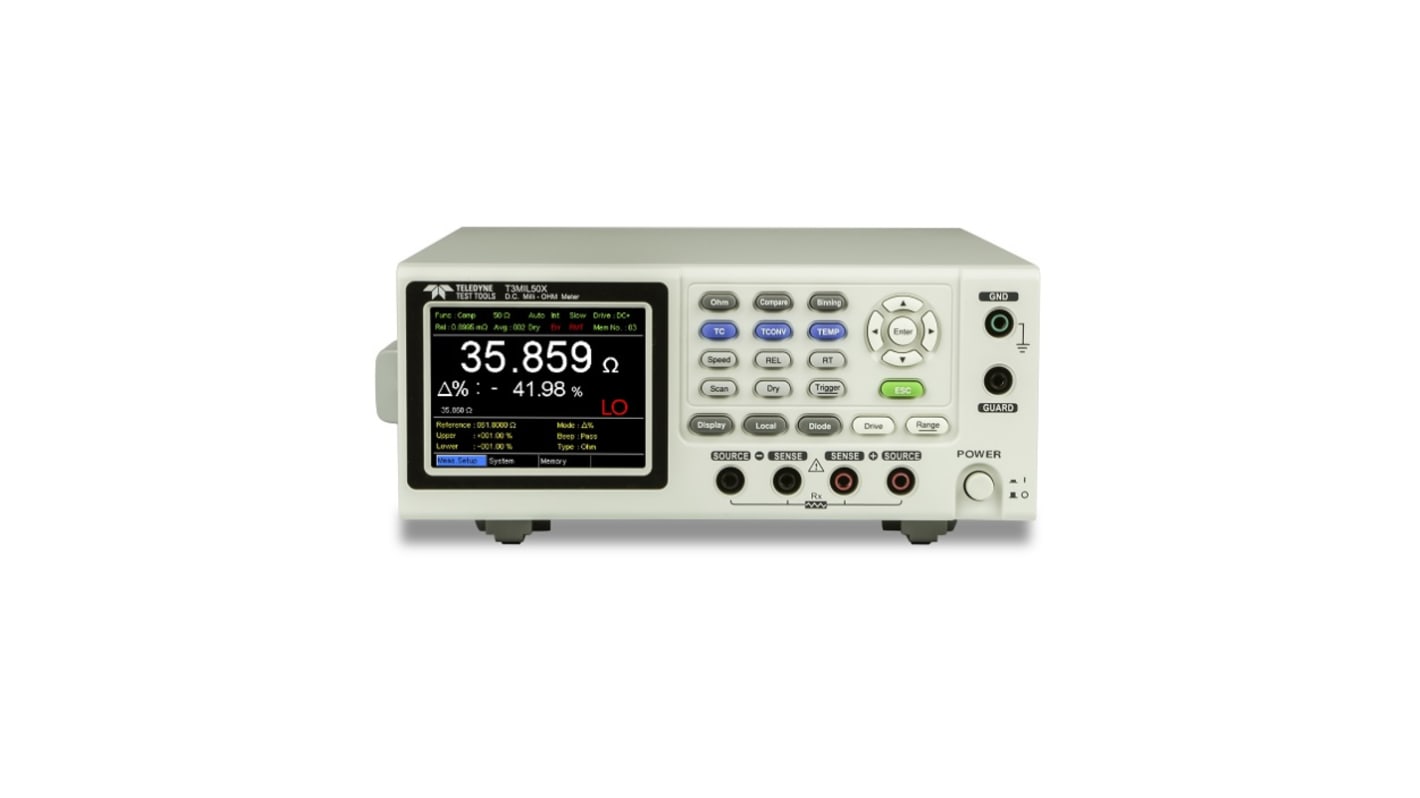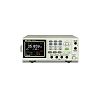Teledyne LeCroy T3MIL Ohmmeter, 5 MΩ Max, 1μΩ Resolution, 4 Wire
- RS Stock No.:
- 245-5566
- Distrelec Article No.:
- 303-71-055
- Mfr. Part No.:
- T3MIL50X
- Brand:
- Teledyne LeCroy

Subtotal (1 unit)*
£1,459.45
(exc. VAT)
£1,751.34
(inc. VAT)
FREE delivery for orders over £50.00
Temporarily out of stock
- 1 unit(s) shipping from 16 February 2026
- Plus 3 unit(s) shipping from 30 March 2026
- Plus 1 unit(s) shipping from 10 April 2026
Need more? Click ‘Check delivery dates’ to find extra stock and lead times.
Units | Per unit |
|---|---|
| 1 + | £1,459.45 |
*price indicative
Calibration Options:
Each
£1,529.95
(exc. VAT)
£1,835.94
(inc. VAT)
- RS Stock No.:
- 245-5566
- Distrelec Article No.:
- 303-71-055
- Mfr. Part No.:
- T3MIL50X
- Brand:
- Teledyne LeCroy
Specifications
Technical Reference
Legislation and Compliance
Product Details
Find similar products by selecting one or more attributes.
Select all | Attribute | Value |
|---|---|---|
| Brand | Teledyne LeCroy | |
| Maximum Resistance Measurement | 5 MΩ | |
| Resistance Measurement Resolution | 1µΩ | |
| Measurement Type | 4 Wire | |
| Power Source | Mains | |
| Dimensions | 223 x 102 x 283mm | |
| Weight | 3kg | |
| Height | 102mm | |
| Length | 283mm | |
| Model Number p | T3MIL | |
| Width | 223mm | |
| Select all | ||
|---|---|---|
Brand Teledyne LeCroy | ||
Maximum Resistance Measurement 5 MΩ | ||
Resistance Measurement Resolution 1µΩ | ||
Measurement Type 4 Wire | ||
Power Source Mains | ||
Dimensions 223 x 102 x 283mm | ||
Weight 3kg | ||
Height 102mm | ||
Length 283mm | ||
Model Number p T3MIL | ||
Width 223mm | ||
- COO (Country of Origin):
- CN
Teledyne LeCroy D.C. Milli-OHM Meter - Advanced Features
Teledyne Test Tools introduces a brand new series of D.C. Milli-Ohm meters. The T3MIL series offers two models T3MIL50 and T3MIL50X, which features a 3.5-inch TFT display with a measurement accuracy of 0.05 %, maximum 50,000 count measurement display and sampling rate of 60 readings per second. The T3MIL series also provides four wire measurement as well as temperature measurement and temperature compensation functions to meet the requirements of low resistance measurement applications.
The T3MIL50X provides Dry circuit and various drive modes (DC+, DC-,Pulsed, PWM) for measurement applications on different materials. The pulsed current output mode is suitable for interacting conductors of different materials to reduce the influence of thermal EMF on the measurement. Thermal EMF is caused by electric potential difference generated from different conductors acting on different temperatures while conducting low resistance measurements.
The DC+ and DC- output modes are best for the measuring of inductive components.
The PWM output mode is suitable for measuring temperature sensitive materials to avoid any resistance variation caused by measurement current being applied for a long period of time.
Dry circuit testing is used to detect contaminates and oxides on mating contact surfaces. Typically, a dry circuit test is performed in conjunction with environmental stress
tests intended to create contamination or metal oxides on connector contact surfaces.
The DC+ and DC- output modes are best for the measuring of inductive components.
The PWM output mode is suitable for measuring temperature sensitive materials to avoid any resistance variation caused by measurement current being applied for a long period of time.
Dry circuit testing is used to detect contaminates and oxides on mating contact surfaces. Typically, a dry circuit test is performed in conjunction with environmental stress
tests intended to create contamination or metal oxides on connector contact surfaces.
Excessive current through the contacts during testing can cause a physical change in the contact area on a microscopic level. Current can cause heating, which can soften or melt the contact points and surrounding area. The contact area enlarges, resulting in a reduction in resistance. To avoid “wiping away” the con taminates, a dry circuit method is used for testing. A dry circuit is one in which the voltage and current are limited to levels that can't cause changes in the physical and electrical condition of the contact junction. Generally, the open circuit voltage is 20 mV or less and the short circuit current is 100 mA or less. The Dry circuit measurement can also
be made in DC+, DC- and Pulsed modes.
be made in DC+, DC- and Pulsed modes.
Features & Benefits
Dry circuit testing
50,000 Counts Display
Fast measurement of 60 readings per second
High Accuracy of 0.05 %
1Amp Test Current, 0.1 μΩ Resolution
3.5” (320 x 240) TFT LCD Display
50,000 Counts Display
Fast measurement of 60 readings per second
High Accuracy of 0.05 %
1Amp Test Current, 0.1 μΩ Resolution
3.5” (320 x 240) TFT LCD Display
Applications
Production testing of contact resistance of switches, relays, connectors, cables, and other low Resistance Devices
Production testing of various inductive components (coil, choke, and transformer winding etc.
Testing of low value resistors, fuses, and heating elements
Winding resistance of motors, transformers, solenoids, and ballasts
Conductivity evaluation in product design
Incoming inspection and quality assurance testing
Production testing of various inductive components (coil, choke, and transformer winding etc.
Testing of low value resistors, fuses, and heating elements
Winding resistance of motors, transformers, solenoids, and ballasts
Conductivity evaluation in product design
Incoming inspection and quality assurance testing
Related links
- Teledyne LeCroy T3MIL Ohmmeter - RS Calibrated
- Teledyne LeCroy T3MIL50X Ohm Meter 1μΩ Resolution, 4 Wire
- RS PRO RM-805 Ohmmeter 1μΩ Resolution, 4 Wire
- RS PRO RM-804 Ohmmeter 1μΩ Resolution, 4 Wire
- Cropico DO7 Ohmmeter 100nΩ Resolution, 4 Wire
- Cropico DO4002 Handheld Ohmmeter 1μΩ Resolution, 4 Wire
- Aim-TTi BS407 Ohmmeter 1μΩ Resolution, 4 Wire
- Cropico DO4000 Handheld Ohmmeter 10μΩ Resolution, 4 Wire

